
General Information
Waterfall project management maps out a project into distinct, sequential phases. The following stage of the project can only begin once the prior stage has been completed. The Waterfall system is the most traditional method for managing a project, with team members working linearly towards a set end goal. Every member has a definite role as the goals and phases of the project do not change.
History
Dr Winston Royce, a Director of Engineering tried to cut costs and make is projects more predictable in the 1960s. In a paper he described the “waterfall” process exactly how we know it nowadays.
The “waterfall” process became an important process in software development, the basis for stage-gate lifecycles and is used for a lot of financial processes.
Advantages
- Replication possibilities; this is an advantage as waterfall workflows can be used for other related activities in the future.
- It is easy and simple to use
- Phases do not overlap
Disadvantage
- One disadvantage of Waterfall is that it is quite inflexible as each task involved is planned in a linear sequence.
- Any change in stakeholder priorities or needs will disrupt the order and require a revision, or possibly an entirely new blueprint.
- Waterfall project management is not very efficient for knowledge based projects. For example, computer programming.
For further information please consult:
https://www.wrike.com/project-management-guide/faq/what-is-waterfall-project-management/
http://tryqa.com/what-is-waterfall-model-advantages-disadvantages-and-when-to-use-it/#:~:text=space%20shuttles%20etc-,Advantages%20of%20waterfall%20model,Phases%20do%20not%20overlap.
https://www.artemisagile.com/the-history-of-waterfall/
